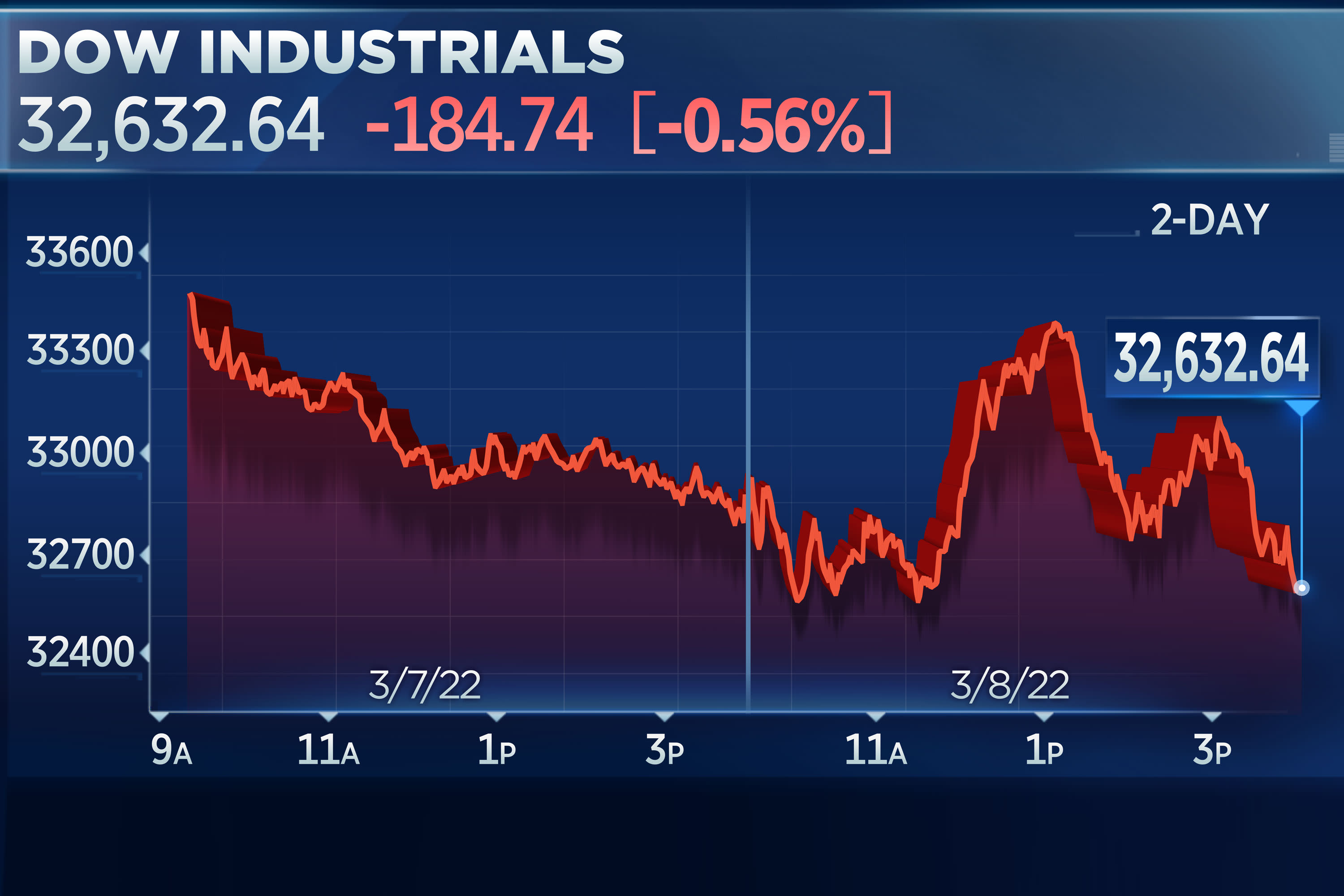
Stocks declined on Tuesday following the S&P 500’s worst day since October 2020, as investors continue to assess geopolitical tensions between Russia and Ukraine and high commodity prices.
The Dow Jones Industrial Average dropped 184.94 points, after being up 585 points earlier in the session. The Dow fell deeper into correction territory. The S&P 500 fell 0.7%, also dropping further into a technical correction. The Nasdaq Composite slid 0.3%, falling deeper into bear market territory.
The small-cap benchmark Russell 2000 bucked the market trend and rose 0.6% on Tuesday.
Investors continue to evaluate surging commodity prices and slowing economic growth stemming from Russia’s invasion of Ukraine. Rising prices for oil, gasoline, natural gas, and precious metals like nickel and palladium are fueling concerns about a slowdown in global growth amid surging inflation.
WTI crude oil jumped about as much as 7% to above $128 a barrel on Tuesday as President Joe Biden said the U.S. will ban Russian oil imports. Oil prices spiked to start the week with U.S. crude hitting a 13-year high of $130.
The energy sector was a bright spot on Tuesday amid surging oil prices. Shares of Chevron and Exxon each rose 5% and 2.5%, respectively. Plus, solar and other clean energy stocks moved higher as the continued rise in oil prices shifted focus toward alternative energy sources. Enphase Energy and SunPower added 14% and 21%, respectively.
Airlines and cruise lines also advanced. Delta Air Lines rose 6% and American Airlines popped more than 9%. Southwest and United Airline were up 7% a piece. Norwegian Cruise Line also rose more than 7%.
Tuesday’s “bounce was a small victory that the low may be in, but it may have to be tested again either later today or later this week,” said Jim Paulsen, chief investment strategist for the Leuthold Group.
The international benchmark, Brent crude, reached a high of $139.13 at one point overnight Sunday before settling at $123.21 per barrel, its highest since July 2008. Brent most recently was up 2% to $126.
The jump in crude is already starting to hit consumers’ wallets. The national average for a gallon of regular gas rose to $4.173 on Tuesday, according to AAA. The prior record was $4.114 from July 2008, not adjusted for inflation.
Other commodity prices also resumed their push higher. Nickel prices on Tuesday briefly touched a new record above $100,000 a metric ton.
Futures for palladium, a key metal in the manufacture of electronics, jumped another 5% to $3.04 an ounce, while platinum futures rose nearly 3% to $1,149.70 an ounce.
“Perhaps there’s some relief that only the US is cutting off Russian oil/gas right away while the UK and EU implement their plans over the course of several quarters. In addition, while the consensus narrative on Russia/Ukraine is quite gloomy, the ingredients for a ceasefire are falling into place,” said Adam Crisafulli, founder of Vital Knowledge.
Treasury yields also were sharply higher, with the benchmark 10-year note up close to 10 basis points to 1.85% as investors shed bonds as inflation fears escalate. Yields move opposite price.
The market action came after a steep sell-off on Wall Street where the S&P 500 dropped nearly 3% for its worst day since October 2020. The blue-chip Dow tumbled almost 800 points for its fifth negative session in six, while the Nasdaq Composite, which contains many of the market’s biggest tech names, slid 3.6%, falling into bear market territory, down 20% from its record high from November.
Investors continued to monitor developments of escalated geopolitical tensions. Ukraine said Moscow is seeking to manipulate its cease-fire arrangement by only allowing Ukrainian civilians to evacuate to Russia and Belarus.
Shell apologized for buying cheap Russian oil and said it was divesting itself of all hydrocarbon holdings in the country. Russia itself warned that crude prices could hit $300 a barrel should Western countries enact a ban on exports. Shell shares popped 3% on Tuesday.




